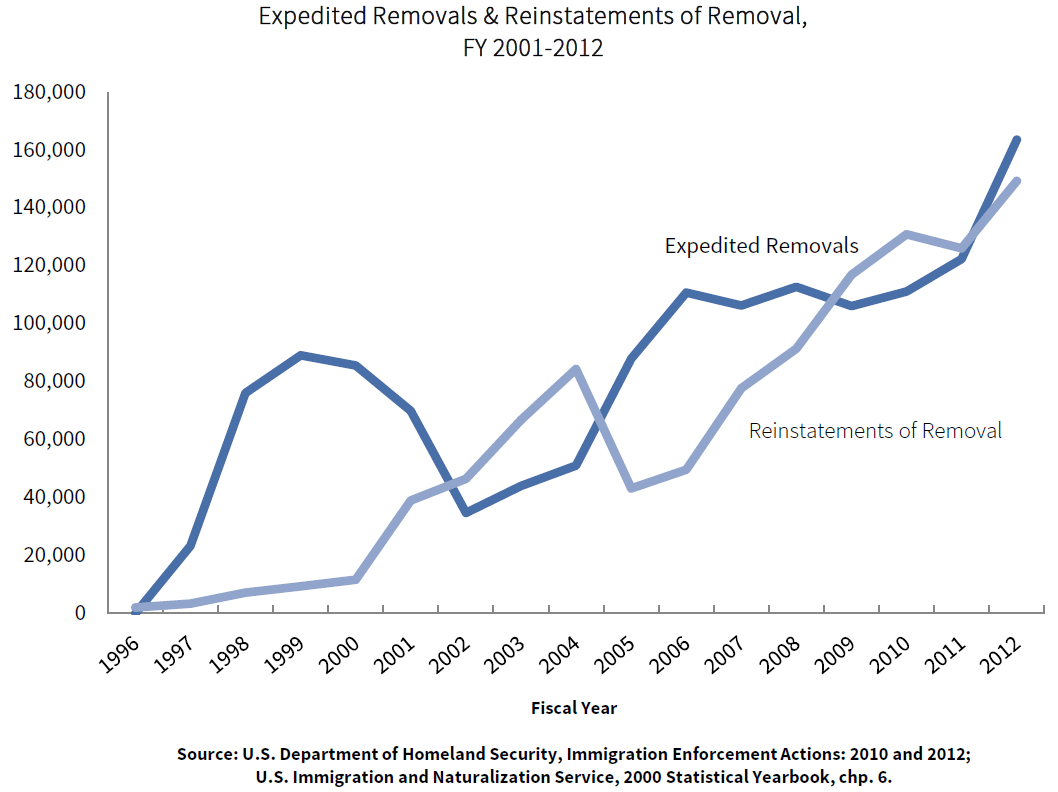The deportation process has been transformed drastically over the last two decades. Today, two-thirds of individuals deported are subject to what are known as “summary removal procedures,” which deprive them of both the right to appear before a judge and the right to apply for status in the United States. In 1996, as part of the Illegal Immigration Reform and Immigrant Responsibility Act (IIRIRA), Congress established streamlined deportation procedures that allow the government to deport (or “remove”) certain noncitizens from the United States without a hearing before an immigration judge. Two of these procedures, “expedited removal” and “reinstatement of removal,” allow immigration officers to serve as both prosecutor and judge—often investigating, charging, and making a decision all within the course of one day. These rapid deportation decisions often fail to take into account many critical factors, including whether the individual is eligible to apply for lawful status in the United States, whether he or she has long-standing ties here, or whether he or she has U.S.-citizen family members.
In recent years, summary procedures have eclipsed traditional immigration court proceedings, accounting for the dramatic increase in removals overall. As the chart below demonstrates, since 1996, the number of deportations executed under summary removal procedures—including expedited removal, reinstatement of removal, and stipulated removal (all described below)—has dramatically increased.

In Fiscal Year (FY) 2013, more than 70 percent of all people Immigration and Customs Enforcement (ICE) deported were subject to summary removal procedures.
Expedited Removal (INA § 235(b))
In FY 2013, ICE deported about 101,000 people through the expedited removal process. Expedited removal is a summary process for formally deporting certain noncitizens who do not have proper entry documents and who are seeking entry to the United States at a port of entry (POE), such as a border crossing or an airport, or who are found within 100 miles of the border. Specifically, it applies only if the immigration officer determines that an individual:
- committed fraud or misrepresented a material fact for purposes of seeking entry to the United States;
- falsely claimed U.S. citizenship; or
- is not in possession of a valid visa or other required documentation.
When expedited removal was first enacted, immigration officers applied it only to people who were seeking entry to the United States and not to those who were already in the United States. However, in 2004, the Department of Homeland Security (DHS) drastically expanded the scope of expedited removal by deciding that noncitizens encountered within 100 air miles of the southwest border who have not been present in the United States for the 14 days immediately prior to the date of encounter can be subject to expedited removal. In 2006, DHS announced that it would implement this policy along all of the U.S. borders.
A person subject to expedited removal is immediately ordered removed without any further hearing, review, or opportunity to apply to stay in the United States unless the person expresses a fear of persecution, in which case he or she is afforded a “credible fear interview” to determine whether he or she may apply for asylum. The process is so truncated that frequently a person with an expedited removal order has no idea why he or she was deported. Individuals subject to expedited removal generally are not informed of their right to counsel. Likewise, they are not provided a sufficient opportunity to contact counsel to help them challenge the charges against them or present evidence that is not with them at the time of apprehension.
As a result, expedited removal can lead to erroneous deportations of individuals who are not deportable or who would be eligible to apply for lawful status in the United States or to seek prosecutorial discretion if processed through normal immigration court procedures. In addition, individuals who may have resided in the United States for decades, and left only for a brief period of time, may be deported pursuant to expedited removal despite having significant ties to the United States. Those subject to expedited removal are automatically barred from returning to the United States for five years. In cases where an expedited removal order is based on a false claim of U.S. citizenship, an individual is permanently barred from re-entering the country.
Reinstatement of Removal (INA § 241(a)(5))
In FY 2013, 159,634 individuals were deported based on a reinstatement of removal order, a 270 percent increase from 2005. Reinstatement of removal applies to noncitizens who return illegally to the United States after having previously been deported. Essentially, DHS “reinstates” the original removal order without considering the individual’s current situation, reasons for returning to the United States, or the presence of flaws in the original removal proceedings. They even may apply it to someone whose initial deportation order was entered in absentia. A person whose order is reinstated is barred from applying to remain in the United States or from seeking to correct any errors that may have occurred in the original deportation. The primary exception to this rule is that an individual who expresses a fear of return during the reinstatement process must be referred to an asylum officer for screening for eligibility for withholding of removal or protection under the Convention Against Torture.
Unlike expedited removal, immigration officers may use the reinstatement process anywhere throughout the United States—not just at a POE or within 100 miles of the border. Most persons subject to reinstatement are arrested and kept in custody throughout the process without an opportunity to seek a bond. The process is designed to allow DHS to remove individuals immediately; the entire process (including the removal) may occur within 24 hours. Typically, the DHS officer conducts a short interrogation to determine whether the individual has a prior removal order, actually is the person identified in the prior order, and has unlawfully reentered. At the conclusion of the interrogation, the person is afforded an opportunity to make a statement and, thereafter, the officer typically issues the final order. The process usually happens too quickly for an individual to consult with a lawyer to assist in challenging the reinstatement.
Stipulated Removal (INA § 240(d))
Stipulated removal orders are different from expedited removal orders and reinstated removal orders in that the person is formally charged and placed in immigration court proceedings before an immigration judge. However, like these other summary removal procedures, the person usually does not appear in an immigration court; rather, the noncitizen agrees (or “stipulates”) to deportation and gives up his or her right to a hearing. The immigration judge may enter the order of removal without seeing the person and asking him or her whether the stipulation was entered into knowingly and voluntarily. The use of stipulated removal expanded from zero in 2000 to over 30,000 in 2008.
Of the more than 160,000 noncitizens who agreed to stipulated removal orders between 2004 and 2010, the vast majority were in immigration detention—often far from family and home—and unrepresented by counsel. The correlation between detention and stipulated removals is particularly troubling given that individuals in detention have little access to lawyers or even basic information about their legal options and because the conditions of confinement are inherently coercive. Until they go before an immigration judge, they may not know whether they have claims to immigration relief, and they may not appreciate the timeframes for making decisions in their cases. ICE agents who ask detainees to sign stipulated removal orders often leave the individuals confused about their options and feeling pressured to agree to give up their right to hearings. As a result, many stipulated removals cannot be said to be voluntary, knowing, and intelligent, and the procedure raises serious due process concerns.
Conclusion
The deportation process has been transformed drastically over the last two decades. In the past, immigration court hearings were the standard procedure. These judicial proceedings ensure a basic level of due process, help safeguard against unlawful removals, and permit noncitizens to pursue legal status in the United States, if they are eligible. Today, two-thirds of individuals deported are subject to summary removal procedures which deprive them of both the right to appear before a judge and the right to apply for status in the United States. The deportation decisions are made quickly by immigration officers, and generally there is no opportunity to consult with counsel and there is no judicial oversight. Even immigrants who are put into the immigration court process may not make it to court if they stipulate to deportation before their first hearing. The stipulation may occur quickly and without the assistance of an attorney.
Too little attention has been paid to this dramatic shift away from fundamental principles of fairness and due process. One of the hallmarks of the U.S. justice system is the right to have a day in court before an impartial decision-maker, yet the vast majority of immigrants who are removed never see the inside of a courtroom. Understanding this transformation from immigration court process to streamlined procedures is an important step in unraveling the breadth and scope of U.S. deportation policies today.




